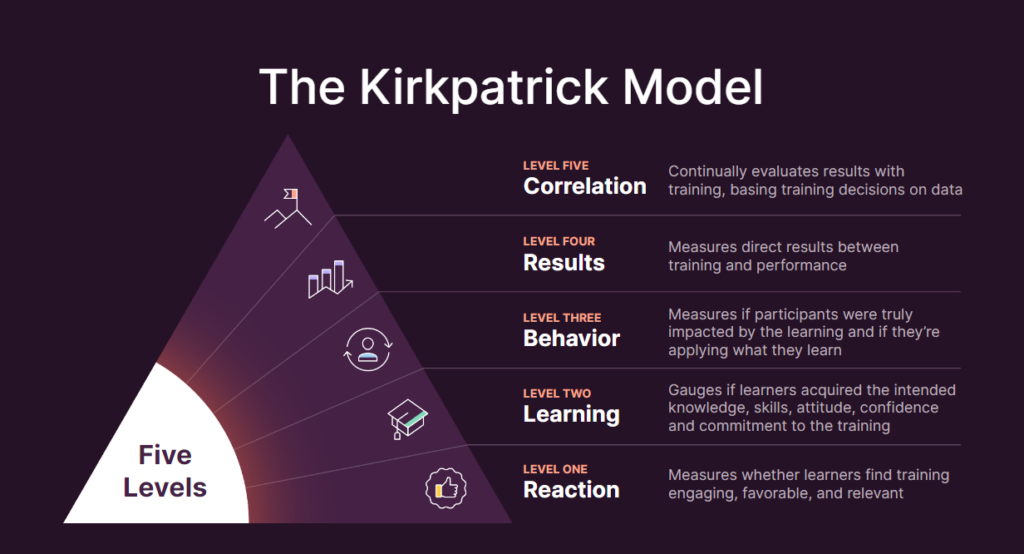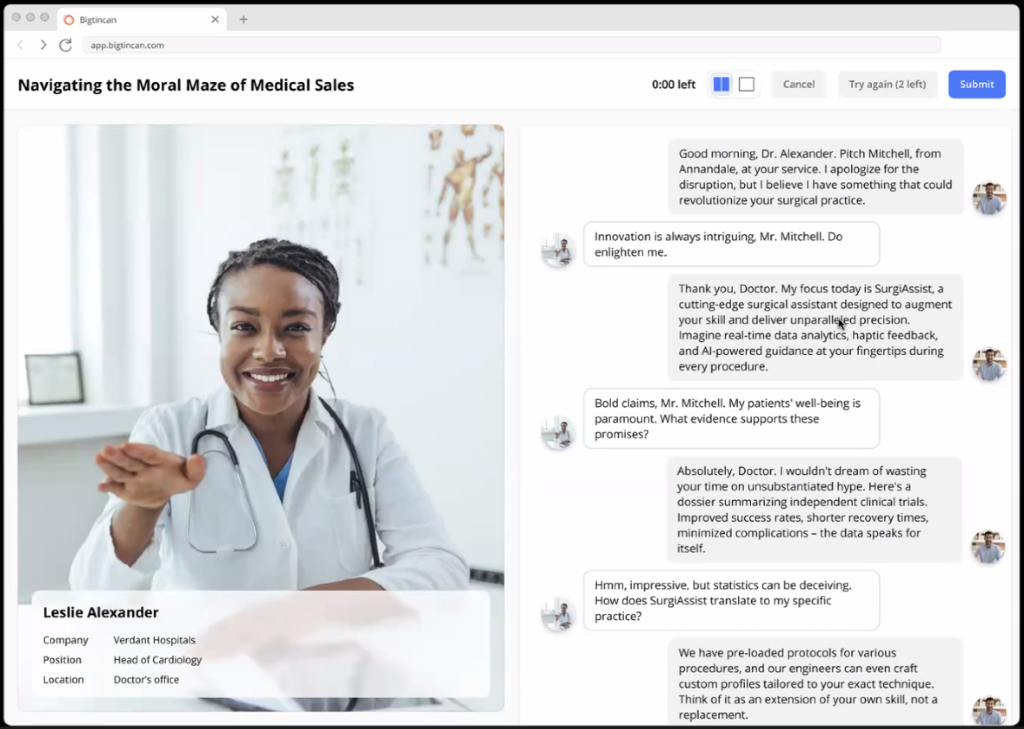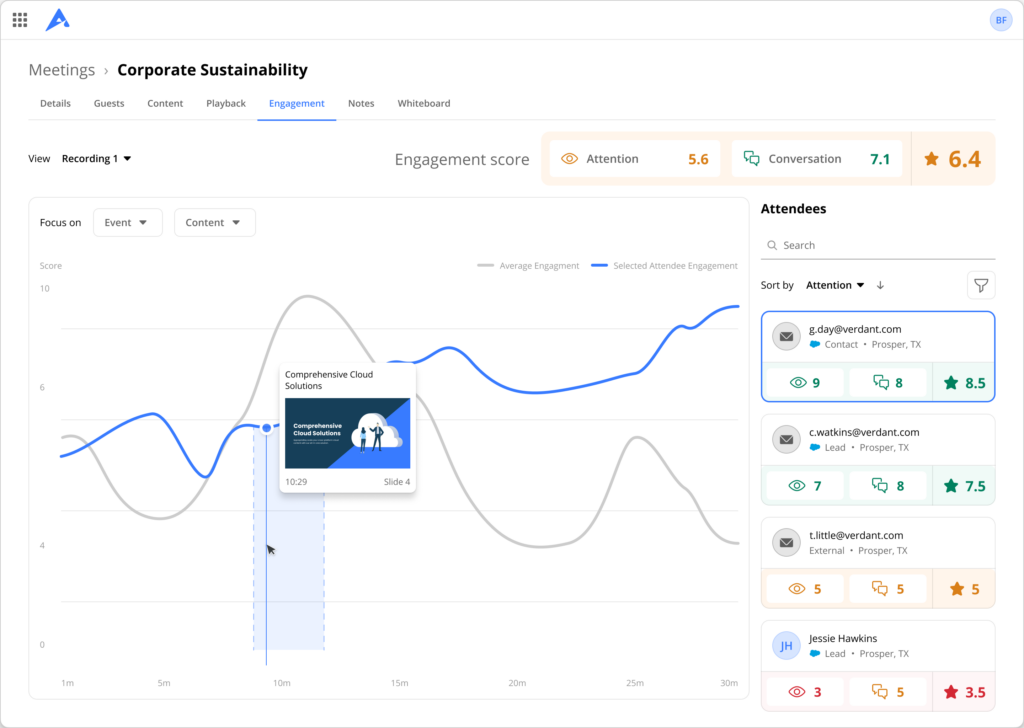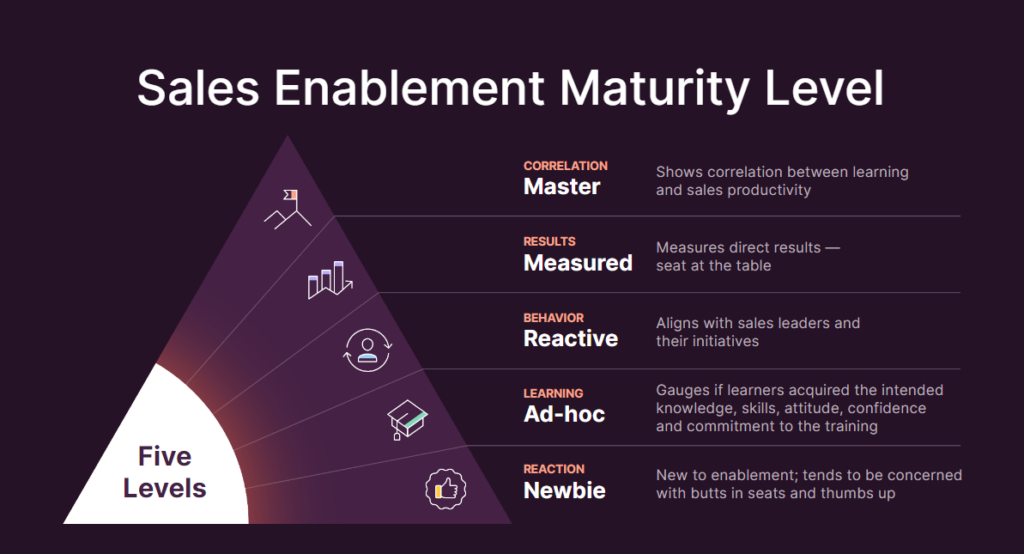It often takes years of experience in an enablement or learning-focused role to build strategic processes and secure sales enablement buy-in, but the time to ramp up your enablement maturity is now.
Current trends in corporate cost-cutting call for enablement practitioners to both increase and prove the business value of their training initiatives sooner rather than later. However, ensuring effectiveness and executive buy-in of sales enablement initiatives requires a structured approach to evaluation.
Enter the Kirkpatrick model, a renowned framework designed to assess the impact of training programs.
Our own in-house enablement expert, Boston Chapter Lead of Women in Sales Enablement and Director of Sales Enablement Beverlie Heyman, has designed a Sales Enablement Maturity Model demonstrating how enablement practitioners can apply the Kirkpatrick model to their programs in order to earn their seat at the table and become strategic business partners with executive leadership.
Here’s an overview of your path to securing sales enablement buy-in by applying the Kirkpatrick Model to sales enablement maturity.
Understanding the Kirkpatrick Model
The Kirkpatrick learning program evaluation plans often include “onboarding, product and program launches, leadership development, diversity, equity, and inclusion (DEI), safety, security, and succession planning” (source).
The Kirkpatrick Model typically consists of the following four levels of evaluation. You can see our version of it here:

1. Reaction
This level focuses on gathering feedback from participants regarding their reactions to the training program.
For sales enablement practitioners, this involves soliciting input from the sales team on the quality, relevance, and usefulness of the resources, tools, and training materials provided to them.
Surveys, focus groups, and one-on-one interviews can be valuable tools for collecting this kind of qualitative feedback.
2. Learning
The learning level evaluates the extent to which participants have acquired the intended knowledge, skills, attitudes, confidence, and commitment as a result of the training.
When applied to sales enablement, this entails assessing the sales team's mastery of essential concepts, techniques, and best practices necessary for effective customer engagement and sales performance.

Medical sales call practice using RoleplayAI
Quizzes, assessments, role-playing exercises, and observations of sales interactions can provide insights into the team's learning progress that help identify gaps and tailor future enablement activities to address specific needs.
3. Behavior
Behavioral evaluation examines the extent to which participants apply what they've learned during training in their day-to-day interactions with customers.
At this level, sales enablement practitioners usually observe sales calls, analyze customer feedback, and track key performance indicators related to sales effectiveness.

Meeting Analytics reflecting buyer engagement during sales presentation
Assessing behavioral changes lets practitioners determine whether enablement initiatives are translating into tangible improvements in sales team performance — exactly the type of data needed to prove enablement impact.
Identifying behavioral gaps also enables practitioners to provide targeted coaching and support to enhance on-the-job application of learned skills and techniques.
4. Results
The results level measures the ultimate outcomes or results achieved as a result of the training.
Enablement managers can measure results via metrics such as increased sales revenue, improved conversion rates, enhanced customer satisfaction, and higher win rates.

Brainshark (Bigtincan Learning) CRM Scorecards
Tracking and sharing results links enablement efforts to concrete business outcomes, which helps secure continued support and investment from key stakeholders. Regularly analyzing results also allows practitioners to refine their strategies and focus on activities that deliver the greatest impact.
Applying the Kirkpatrick Model to sales enablement
With so many shared focus areas (onboarding, product and program launches, leadership development), the Kirkpatrick model is easily adapted to sales enablement contexts.
But since what you do with your results is more important in sales enablement and business contexts than simply getting results, we’ve added a fifth level to both the Kirkpatrick and Sales Enablement Maturity Models reflecting enablement mastery and correlation of learning results to sales outcomes.
Here's the Kirkpatrick Model overlaid with Beverlie's Sales Enablement Maturity levels:

To effectively apply the Kirkpatrick model in sales enablement, practitioners should follow these key steps:
- Define clear objectives. Clearly outline the objectives and desired outcomes of sales enablement initiatives, ensuring alignment with overall business goals and sales priorities.
- Design relevant training programs. Develop training programs and resources that address the specific needs and challenges of the sales team, incorporating a mix of instructional methods like formal courses and interactive learning activities such as quizzes, coaching challenges, and roleplays.
- Collect learner/seller feedback. Gather feedback from participants at each level of the Kirkpatrick model using surveys, assessments, interviews, and other feedback mechanisms.
- Analyze learning, coaching, and sales data. Analyze feedback, learning outcomes, behavioral changes, and business results to identify trends, patterns, and areas for improvement.
- Iterate and improve enablement programs. Use insights gained from evaluation to iterate and improve sales enablement initiatives, refining content, delivery methods, and support mechanisms to drive continuous improvement.
- Communicate enablement results. Communicate the impact of sales enablement efforts to key stakeholders, highlighting successes, lessons learned, and opportunities for future enhancement.
Secure sales enablement buy-in
The Kirkpatrick Model applied to sales enablement maturity provides a systematic framework for evaluating the effectiveness of enablement initiatives at multiple levels.
By following this model, enablement practitioners can gain valuable insights into the impact of their efforts, identify areas for improvement, drive better sales performance, and become a strategic business partner to executive leadership.
Need help assessing your enablement maturity level? Download the complete guide.
It covers:
- Sales enablement milestones
- Sales enablement charters and competency models
- Skill sets to prioritize at early stages
- How to assess your current state
- What happens at each stage of enablement
- How to move from stage to stage
- How to earn and keep your seat at the table as an enablement practitioner
- And more
